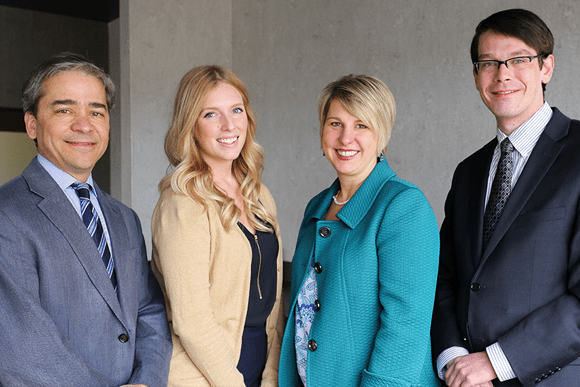
Fostering an idea into a fully implemented project is the focus in this installment of In the Gears, a series that highlights the tools PSC uses to turn the gears of public policy innovation. Other focus areas include research, evaluation and defining problems and solutions through facilitation, strategic counsel and strategic planning.
One of the cornerstones of Public Sector Consultants’ work is program implementation — the ability to guide a project through every step from idea to reality. Perhaps nowhere is this better seen than the Great Lakes Fishery Trust, a nonprofit organization dedicated to the health of the Great Lakes fishery. PSC has managed and staffed the GLFT since its inception.
PSC provides the GLFT access to staff with expertise in areas like natural resource management, fisheries, marketing and communications, place-based education, administration and more.
“PSC’s ability to move the needle on public policy clearly spills over into the trust’s work,” says Mark Coscarelli, GLFT co-manager and PSC vice president. “It’s not just funding the right kinds of projects — it’s connecting the project’s results to inform policies and procedures that management agencies are using today.”
The GLFT was a result of a 1996 settlement, which involved years of litigation between private organizations, government entities, Indian tribes and the utilities that operated the Ludington Pumped Storage Plant. Established in 1973 and located off Lake Michigan in Ludington, the Ludington Pumped Storage Plant is a hydroelectric plant and reservoir that is owned jointly by Consumers Energy and DTE Energy. Its operation was resulting in fish mortality, negatively impacting Lake Michigan fish populations.
“It’s not just funding the right kinds of projects — it’s connecting the project’s results to inform policies and procedures that management agencies are using today.”
Jack Bails, senior policy fellow at PSC and former deputy director of the Michigan Department of Natural Resources, contributed to the settlement. His knowledge helped shape the GLFT’s organizational framework.
“Jack’s vision became a cornerstone for the trust’s success,” Coscarelli says.
After 10 years of negotiations and legal proceedings, the parties agreed to create a trust with the following mission: “To provide funding to nonprofit organizations, education institutions, and government agencies to enhance, protect, and rehabilitate Great Lakes fishery resources. The GLFT will manage its resources to compensate for lost use and enjoyment of the Lake Michigan fishery resulting from operation of the Ludington Pumped Storage Plant.”
In the nearly 20 years since the settlement, the GLFT has granted more than $64 million in fishery projects that have reduced the plant’s impact on the fishery. These grants have been made possible with invested money from the settlement, in addition to annual payments for ongoing fish losses from Consumers Energy and DTE Energy.
“The GLFT has proven to be a very practical funding resource to mitigate the damages of the Ludington Pumped Storage Plant’s continued operation,” says Jon Beard, GLFT grant manager and PSC consultant.
Those funding resources include support for fishery access, ecosystem health and sustainable fish populations, Great Lakes stewardship and special projects. The GLFT is the largest funding source for hypothesis-driven research that benefits the health of the Great Lakes fishery within the Great Lakes basin.
“Tracing the GLFT back to its roots, it was very novel and innovative in how it was created,” Coscarelli says. “The parties of the settlement could have divided their spoils and gone their own way. They decided they could do better and pooled those settlement dollars together.”
The funding for its projects is primarily granted through a proposal process.
“We issue requests for proposals that advance the trust’s mission and work with prospective applicants to develop proposals that will achieve those goals,” Beard says.
A recent GLFT-funded project is the Boardman River restoration project, which aims to remove three of the four dams located on the Boardman River in Michigan’s Grand Traverse Bay. The removal will restore connectivity to the Great Lakes, lower water temperature, increase sediment transport and enhance nursery habitat for after fish spawning.
“The Boardman River restoration project is a great example of how the GLFT realizes its mission,” Coscarelli says. “There’s been a long, desired effort to make the fishery self-sustaining. And while that will never be 100 percent possible, we can make significant improvements by funding these projects.”
Ecosystem health and fishery sustainability grants help improve the Great Lakes, but access grants enhance the public’s ability to use and enjoy the lakes. Since the GLFT started issuing grants, it has funded improvements to more than 50 parks along the Great Lakes shoreline. These projects have included construction of piers, fishing decks, riverwalks and fish cleaning stations as well as enhancements to breakwalls. These grants represent about 22 percent of the of the GLFT’s grant portfolio.
“While each access project has made important improvements at individual parks, the combined impact of the GLFT’s grantmaking has substantially increased public access to the Great Lakes fishery,” Beard says.
While access grants give the public opportunities to enjoy our natural resources, the Great Lakes Stewardship Initiative (GLSI) gives children the opportunity to expand their knowledge of these resources. With help from the Wege Foundation and other funding partners, the GLFT funded the GLSI in 2007. The GLSI incorporates hands-on, place-based learning in order to create Great Lakes stewards in local communities. K-12 teachers and students within the GLSI’s nine regional hubs work with local organizations to understand and address environmental issues within their community, which supports their knowledge of core academic subjects such as science, technology and math.
Currently, the GLSI is working on its fifth annual place-based education conference, which takes place November 5–7 in Grand Rapids and represents one of the GLFT’s goals of supporting Great Lakes stewardship.
Another goal for 2015 is to make the results from GLFT-funded projects — like research — more accessible to Great Lakes resource managers and interested parties. This summer, the GLFT is launching a newsletter that is aimed at doing just that.
“We’re working on putting what we’re doing into the hands of people who need it the most,” Beard said. “That’s a focus of 2015 and beyond. There’s a lot of good work out there that doesn’t make it to people that would benefit from it.”
“This initiative is just another example of how the GLFT provides value to the Great Lakes fishery,” Coscarelli added. “Everything we do is focused on that mission, and each year we make more and more progress.”


